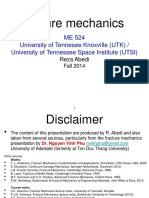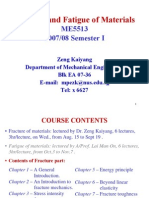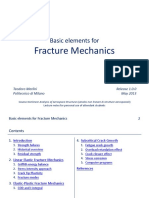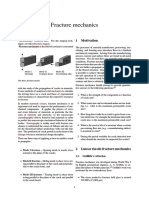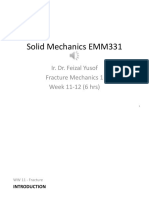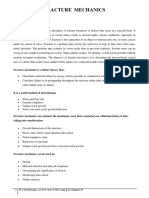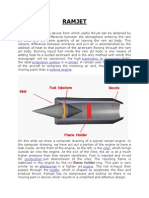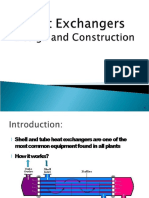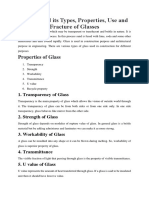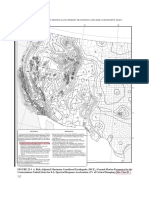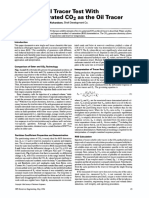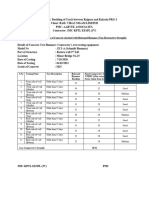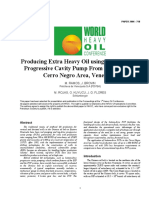Chapter 1: Introduction to Fracture Mechanics
1.1 Introduction
Conventional design philosophy
• Strength (σys) • Avoid Stress
• Buckling Concentration
• Deflection
• Improved NDE
Changes • Defect is not the end of life
• Cost of Replacement & Repair
• Possibility of continued service
Fracture Mechanics
Historical failures
Failure of Liberty Ships
During World War II
Built more than 2500 Liberty Class Ships
About 700 experienced sever structural failures
about 145 broke into two parts.
Reasons:
- Flaws in welded joints
- High strength materials were used (Low fracture toughness)
- Low temperature further reduced the fracture toughness.
1982 National Bureau of Standards Study
Costs associated with:
- Direct losses and imputed costs
- Over design of structures because of
- non-uniform material quality
- inspection, repair, and replacement of degraded component
About $120 Billion/year
Savings that can be achieved from:
• Current Fracture Mechanics Technology about $35B (30%)
• Future Fracture Mechanics Technology: additional $28B.
1
� 1.2 Evolution of Structural Design
Empirical Adaptation of Previous The Pyramids
Successful Designs: The great Cathedrals in Europe
Trial & Error Procedures
σ nom
Strength of Materials Approach 19th Century discoveries
Theory of Elasticity with Large by Cauchy and others
factor of Safety
2b
Inglis (1913, USA)
Recognition of Stress Kolosov (USSR) R
Concentrations Paradox
σ = σnom 1+2 a/R @ R=0, σ -> 0
2a
nom
Fracture Mechanics
Largest Tolerable Flaw for Given Load/ Griffith (1922) σ nom
Safe Operating Load for Given Flaw Size Theory of Rupture
by the Use of LEFM
K(a,σ,B) = KIc Later Developments by
Obriemoff (1930)
Westergaard (1939)
Damage Tolerance Approach: Irwin & Orowan (1948)
- Rate of Growth of Flaws Rice & Cherepanov (mid 60)
- Critical Size in Service
1.3 HISTORICAL DEVELOPMENT OF FRACTURE MECHANICS
1. 15th Century - Leonardo de Vinci
Strength tests on iron wires of different lengths.
Strength is inversely proportional to volume of the material
2. 19th Century - Cauchy
Stress-strain relation ship at singularities & Stress concentration
3. 1922 Griffith's fracture theory
First quantitative relation between the strength of material and crack size.
(a) Interatomic strength theory
Crystalline properties can be calculated based on its lattice properties
σ th =
Eγ
Theoretical strength, b
E = Elastic modulus
b = Equilibrium atomic spacing
γ = Total interatomic separation
energy
σ σ
b
For many materials γ = Eb/40; yields Atomic model for
σ th ≈ E / 6 theoretical strength
2
� (b) Fracture Theory
Using Inglis mathematical equations for stress concentration, showed for brittle
materials like glass "Surface energy dissipated by forming new crack surfaces is equal to
the resistance to the crack growth"
Westergaard extended Griffith's theory and showed that the fracture strength of
cracked bodies is
σf =
2 Eγ
πa
a is the crack length
Limitations:
1. γ is valid for brittle materials
2. Calculation of γ was not clear a
Cracked body
3. Value of γ was much larger for engineering materials.
4. 1948 George Irwin (US Naval Research laboratory)
Linear Elastic Fracture Mechanics
- Extended Griffith's theory to metals
- Developed mathematical methods to calculate fracture parameter and
measurement of critical fracture parameters (toughness)
E( γ + γ p )
σf = πa
γp = Plastic energy at the crack tip
Since the numerator is a material property, we can define as
σ= K ,
πa
Where K = Stress intensity factor at the crack tip
σ = remote stress
We can relate K to G, rate of change of total potential energy w.r.t. crack length a.
G = K2/E*
E* = effective elastic modulus
This theory is called
Griffith-Irwin-Orowan Theory of Fracture
3
� 5. James Rice (1967) and Cherepanov (1966)
Nonlinear Fracture Mechanics
J = ∂∂a∏
Where Π is the total potential energy of nonlinear (elastic plastic) material
cracked body.
1.4 Mathematical Definition of crack
1.4.1 Definition
Crack is an elliptical notch with a semi-major axis length a (crack length) and
semi-minor length, b, is zero. In other words, radius of curvature at the crack tip is zero.
Elliptical notch σ nom Crack σ nom
2b
2a
2a
σ nom σ nom
1.4.2 Stress Flow Around a Notch & Crack
1.4.2.1 Loading transverse to the major axis 1.4.2.2 Loading parallel to the major axis
Notch Notch
(
Stress concentration (Kt): σ = σ nom 1 + 2 a / Rmin ) (
Stress concentration (Kt): σ = σ nom 1 + 2 a / Rmax )
Rmin is the radius of curvature at the tip of the major axis. Rmax is the radius of curvature at the tip of the major axis.
Crack Crack
K = σ nom πa Stress intensity factor (K) = 0
Stress intensity factor (K):
σ = σ nom
4
� 1.5 Effect of Crack in a Structure
Static Loading
Residual Strength Diagram
σc
Design strength
Expected
Residual highest service
strength load
Normal
2a service load
In-service
W failure Failure
Crack size
σc Time
Fatigue Loading
σ(t)
Load Spectrum
Tension
Stress
2a
Time
W
Compression
σ(t)
Unstable
Crack
length, a
Crack
initiation Crack growth
Cycles
Time
5
� 1.6 Objective of Fracture Mechanics Technology
Develop prediction methods and calculate of how fast cracks will grow and how
fast the residual strength will decrease.
Specifically:
1. What is the residual strength as a function of crack size?
2. What size of a crack can be tolerated at the service load (Critical crack
size)?
3. How long does it take for a crack to grow from a certain initial size to a
critical size?
4. What size of preexisting flaw (crack) can be permitted at the moment
structure starts its life?
5. How often should the structure be inspected?
1.7 Fracture Mechanics Discipline
Includes 4 disciplines:
Engineering – Load 7 Stress Analysis
Applied Mechanics – Crack tip stress field & Driving Force
Testing – Quantify Critical parameters & Verify Analytical Parameters
Material Science – failure process at the atomic scale. Includes dislocations & impurities
FRACTURE MECHANICS

